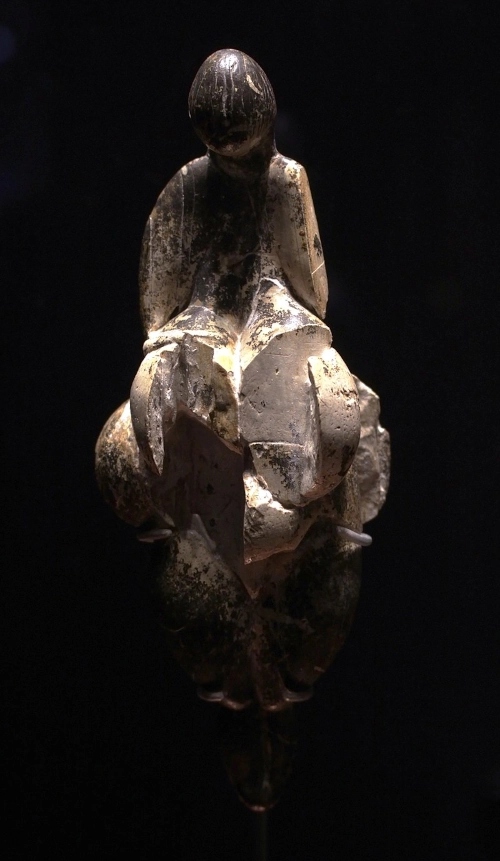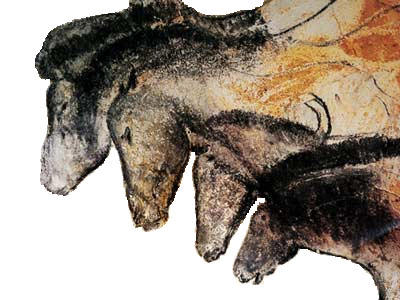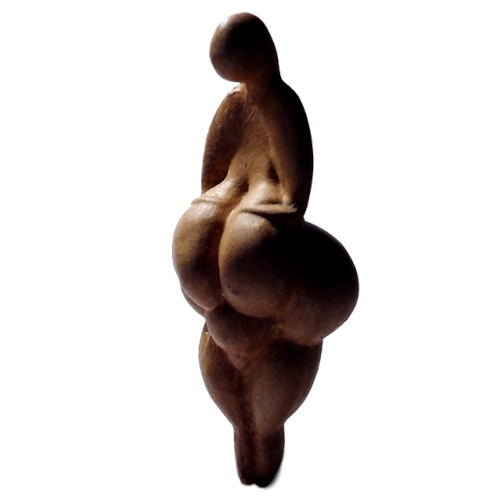It’s a prehistoric statuette of a woman made from mammoth ivory. Discovered in France in 1922 & is estimated to be around 25,000 years old. The Venus of Lespugue is notable for its exaggerated & stylized depiction of female anatomy, with oversized breasts, buttocks, & hips. It is believed to be a representation of fertility or a goddess figure.
Unraveling the Ancient Mystery
Around 25,000 BCE, the Gravettian civilization produced the Venus of Lespugue, a prehistoric ivory figurine. It was found in Lespugue, France, in 1922. The figurine shows a woman with accentuated sexual traits, perhaps a goddess or fertility.
The figurine is a testament to the artistic and cultural accomplishments of early humans and one of the oldest known instances of ancient art. Its importance goes beyond art history because it sheds light on the ideals and beliefs of ancient societies. The Musee de l’Homme in Paris, France now houses the Venus of Lespugue.
What Are The Different Theories About The Figurine’s Origins And Its Meaning?
The Venus of Lespugue figurine’s origins and significance are the subject of numerous hypotheses. Some academics contend that it symbolizes a fertility goddess or a sign of wealth and abundance. Others contend that it represents a shaman or sorceress who played a unique position in ancient society.
According to some researchers, the figurine may have functioned as a handle for a tool or a piece of jewelry. It might have been a doll or toy for kids, according to another hypothesis. Despite these various interpretations, the Venus of Lespugue’s exact function and significance remain a mystery, and it continues to fascinate academics and art lovers equally.
What Are The Different Art Styles That Were Used To Create The Venus Of Lespugue Figurine?
Around 26,000 BCE, during the Gravettian phase of the Upper Paleolithic epoch, the Venus of Lespugue was produced. The figurine was fashioned from mammoth ivory, and its style, which includes exaggerated, curvy feminine features like large breasts (pendulous breasts) and (extremely large) buttocks, is typical of the time. While the legs and torso are mostly smooth, the artist used engraving and incision methods to create the details of the hair, face, and arms. The Venus of Lespugue was painted in the Gravettian style, which is recognized for its representations of the human body, particularly female figures. The figurine’s design is also noteworthy for its emphasis on the feminine form and naturalistic proportions.

Mammoth Ivory
Mammoth ivory is made from the teeth of extinct woolly mammoths, which inhabited the planet between 2.5 million and 10,000 years ago. Mammoth ivory is a priceless substance used in a variety of artistic mediums, including jewelry making, carving, and scrimshaw. Since it does not entail harming living elephants, which are protected by international law, it is legal to use and trade in many nations. Some nations have laws governing the trade in mammoth ivory to prevent it from fueling the illegal traffic in elephant ivory.

Using flint tools, which were frequently used by Paleolithic people, the Venus of Lespugue was carved from mammoth ivory. The artist most likely began by carving the figurine’s basic shape before adding details with smaller instruments. The ivory’s surface was then polished and buffed with grit and water. It is thought that the figure was painted with red ochre or other pigments, but these have since faded with time.
Neanderthals
During the Middle Paleolithic era, between 400,000 and 40,000 years ago, a group of hominids known as the Neanderthals, also known as Neandertals, lived in Europe and some regions of Asia. They have a common ancestor who lived about 600,000 years ago, making them the closest relatives of contemporary humans. Neanderthals had a robust build, a stocky and muscular frame, thick bones, and a big nose that helped them warm and humidify the chilly, dry air in their habitat. They were well-adapted to their environment.
Neanderthals were skilled hunters and gatherers who relied on a diverse diet of animals, plants, fish, and nuts. They crafted tools and weaponry out of stone, bone, and antler while living in caves, rock shelters, and open-air locations. The intricate patterns on their tools, the use of pigments for body decoration, and the custom of burying their deceased with grave goods all serve as evidence of their sophisticated culture.
Neanderthals are also well-known for their interactions with modern humans, who first appeared in Europe about 45,000 years ago. According to some data, Neanderthals and modern humans interbred, as evidenced by the DNA of non-African populations today. However, for unknown causes, Neanderthals went extinct about 40,000 years ago. Competition from contemporary people, alterations to the environment, and a decrease in their genetic diversity are a few potential causes.
The Paleolithic Period
The Paleolithic era, also referred to as the Old Stone Age, lasted from roughly 2.6 million years ago to around 10,000 BCE. Humans were nomadic hunters and gatherers at this period. Their ability to hunt animals and collect wild plants was essential to their existence because they lacked permanent settlements or agriculture.
Paleolithic people lived in small groups and were adept at making stone tools like hand axes, scrapers, and blades that they used for hunting, butchering animals, and other tasks. They also produced art, such as cave paintings and sculptures, and used fire for cooking and warmth.
Ice ages and sharp temperature swings were frequent features of the Paleolithic era’s environment. People living in the Paleolithic era had to adjust to their surroundings by making clothing out of animal hides and homes out of raw materials like wood and animal bones.
Overall, Paleolithic life was difficult, but humans managed to adapt a variety of technologies and skills to live and flourish in various environments. These early discoveries helped clear the way for later agricultural advancements and the rise of civilization.
What Is The Significance Of The Figurine In The History Of Art?
The Venus of Lespugue figurine is important in the history of art because it is one of the earliest known instances of human artistic expression. It provides evidence of the early humans’ symbolic and creative abilities and casts light on their cultural values and practices. The stylized shape and exaggerated features of the figurine also shed light on the evolution of aesthetics and artistic conventions. It continues to inspire both modern artists and art enthusiasts. Its lasting impact can be seen in later artistic traditions and styles.
What Is The Significance Of The Venus Of Lespugue?
The Venus of Lespugue is important in the history of art because it is one of the earliest known examples of prehistoric art, dating to roughly 25,000 BCE. It displays the skill and ingenuity of early humans and is a representation of the female form, which was a common subject in prehistoric art. The figurine is also important in the study of human evolution and the development of human culture and society. Its finding and analysis shed light on the prehistoric humans’ values, beliefs, and artistic expressions. In addition, later art movements, especially those that portrayed the female form, were influenced by the Venus of Lespugue.
Does Its Discovery Have Any Connection To The Chauvet Cave Artworks?
There is no clear relationship between the Chauvet Cave artworks and the Venus of Lespugue figurine, which was found in a different place. The Venus of Lespugue was found in a rock shelter in southwest France, and the Chauvet Cave in the Ardèche area of France is well known for its well-preserved Paleolithic paintings and engravings. However, the Chauvet Cave and Venus of Lespugue artworks both provide insight into the cultural and social customs of prehistoric humans and are significant examples of early human creative expression.

Can We Find Similar Representations In The Grotte Des Rideaux?
The Venus of Lespugue in the Grotte des Rideaux is not known to have any comparable depictions. Southwest France’s Grotte des Rideaux, also known as the Chabot Cave, is home to a number of prehistoric paintings and engravings, most of which feature images of creatures like horses, bison, and ibex. However, some of the engravings in the grotto are geometric and abstract in style. Despite the absence of figurines, the site is still a significant example of prehistoric art and sheds light on early humans’ artistic practices.
Why Does This Venus Statue Exaggerate Female Secondary Sexual Characteristics?
The Venus of Lespugue figurine’s exaggerated female secondary sexual characteristics may be explained by its potential use as a fertility symbol or as a representation of the ideal feminine shape during the Paleolithic era. The Venus figurines may have been made to encourage fertility and guarantee the survival of the human race because the Paleolithic people believed in the power of reproduction. It’s possible that the figurine’s exaggerated characteristics were meant to draw attention to the features of female physiology that were crucial for reproduction. The figurine may also have served as a self-portrait or a means of personal expression, according to some specialists.
What Does Elizabeth Wayland Barber Say About This Sculpture’s Age And Purpose?
The Venus of Lespugue, according to prehistoric textile expert Elizabeth Wayland Barber, was made between 28,000 and 22,000 BCE, during the Gravettian era. She hypothesizes that the figurine may have been used as a representation of the Great Mother, a goddess (Mother Goddess) figure connected to reproduction and creation, or as a fertility symbol. Barber adds that the figurine’s exaggerated features might have been used to convey ideas about the ideal body type or to stress the value of fertility and procreation in ancient societies.
Elizabeth Wayland Barber
American archaeologist Elizabeth Wayland Barber is an authority on ancient fabrics and clothing. She was born on May 4th, 1940, and graduated from Yale University with a doctorate in languages and archaeology. Women’s Work: The First 20,000 Years and The Mummies of Urumchi are two of Barber’s books on the topic. She is best known for her research on the ancient history of textiles and clothing. She has also studied the ancient civilizations of Central Asia and the Aegean during the Bronze Age in great depth. At Occidental College in Los Angeles, Barber is presently Professor Emerita of Archaeology and Linguistics.
Where Is The Venus of Lespugue Located Now?
The Musée de l’Homme in Paris, France is presently home to the Venus of Lespugue. It was found in 1922 in the Pyrenees’ Grotte des Rideaux by French researcher René de Saint-Périer. The figurine was studied and ultimately displayed at the Musée de l’Homme in Paris after Saint-Périer brought it there. The Venus of Lespugue, thought to be one of the earliest known instances of prehistoric art, found a suitable home in the museum because it was devoted to the study of human evolution and prehistory.
Musée de l’Homme in Paris
The Musée de l’Homme is an ethnography museum in Paris, France. It was established in 1937 and is housed in the famed Palais de Chaillot, which has a view of the Eiffel Tower. The museum’s collections include prehistoric artifacts, ethnographic items, and biological specimens that are all linked to human culture and evolution.

Following World War I, the Musée de l’Homme was founded with the intention of fostering scientific study and fostering global understanding. The museum, whose collections and displays continue to draw tourists from all over the world, made a major contribution to the development of anthropology in France and beyond.
The museum holds temporary exhibitions, lectures, and other anthropology and human culture-related events in addition to its permanent exhibits. It is a component of the Muséum national d’histoire naturelle, a collection of museums and academic centers devoted to natural history and associated subjects.
Who Discovered The Venus Of Lespugue Originally?
Rene de Saint-Perier, a French archaeologist who specialized in prehistoric art, found the Venus of Lespugue in 1922. The main responsibility of Saint-Perier was to record and research prehistoric artworks, including those discovered in the caves of southwest France. He was especially interested in the Upper Paleolithic, which is distinguished by its distinctive cave art and moveable artifacts and lasted from roughly 40,000 to 10,000 BCE. Saint-Perier made significant contributions to the study of other prehistoric artworks, such as the cave paintings of Lascaux and Altamira, in addition to finding the Venus of Lespugue. He is regarded as one of the founders of contemporary study on prehistoric art.

Rene de Saint-Perier
Rene de Saint-Perier (1888–1974) was a French archaeologist best known for his vast work in the Pyrenean prehistoric caves. He was raised in Paris and attended the Ecole Normale Superieure after being born in Bordeaux, France. Saint-Perier is renowned for his meticulous documentation of ancient art, including the Venus of Lespugue, which he found in 1922.
Saint-Perier spent many years investigating and excavating prehistoric sites in the Pyrenees, such as the caves of Niaux, Font-de-Gaume, and Les Combarelles. The artwork and artifacts that had been left behind by the prehistoric people who had lived in these caves thousands of years ago piqued his curiosity in particular.
Saint-Perier was renowned for his meticulousness and the cutting-edge methods he employed in his excavation work. He was a pioneer in the use of photography and plaster casts to chronicle prehistoric art, and the subsequent generations of archaeologists have benefited greatly from his meticulous records and pictures.
Saint-Perier carried out archaeological digs not only in the Pyrenees but also in other regions of France, Algeria, and Tunisia. He was a prolific writer and released numerous books and articles on prehistoric art and archaeology.
The study of prehistoric art and archaeology has been influenced by Saint-efforts Perier’s for a long time. Some of the earliest examples of human creative expression have been preserved and documented thanks to his meticulous attention to detail and innovative use of photographic and casting methods.
Dating The Venus of Lespugue
By measuring the amount of carbon-14 in an organic substance, radiocarbon dating was used to establish the age of the Venus of Lespugue. A tiny fragment of mammoth ivory was carefully removed from the figurine to collect the carbon-14 sample, which was then analyzed using a mass spectrometer to determine the figurine’s age. An estimated age of the ivory could then be established by comparing the obtained data to known ratios of carbon-14 in the atmosphere at various points in time. Using this technique of testing, it was determined that the Venus of Lespugue was about 25,000 years old.
Radiocarbon Dating
By calculating the quantity of radioactive carbon-14 in the sample, radiocarbon dating is a method for estimating the age of organic materials. Carbon-14 is a radioactive isotope of carbon that decays over time at a fixed rate. When an organism passes away, it ceases absorbing carbon-14, which causes the carbon-14 in its tissues to start deteriorating. The quantity of carbon-14 that is still present in a sample allows researchers to estimate its age to within about 50,000 years.
A tiny sample of the substance being dated, typically a few milligrams, is taken and transformed into a form of carbon dioxide gas as part of the radiocarbon dating process. The quantity of carbon-14 in the sample is then determined by passing the purified carbon dioxide gas through an accelerator mass spectrometer. The sample’s age is ascertained by comparing the outcomes to a calibration model that accounts for variations in the atmospheric concentrations of carbon-14 over time.
How Do Scientists Use Facial Features To Date Such Sculptures Accurately?
By comparing a sculpture’s facial features to those of similar pieces that have been reliably dated by other techniques, such as radiocarbon dating or stratigraphic analysis, scientists can determine a sculpture’s age. The sculpture’s design and fabrication methods can reveal information about its time of creation. Additionally, particular hairstyles or physical characteristics may be linked to particular historical eras or cultural groups. Researchers can determine a more precise estimate of the sculpture’s age by comparing these characteristics to those of other known instances. It is crucial to remember that this approach is not always accurate and can be impacted by things like area style variations and outside cultural influences.
Are There Other Interpretations Or Explanations For Its Existence Besides Being A Work Of Prehistoric Art?
There are some alternative interpretations and explanations for the Venus of Lespugue’s existence, despite the fact that it is generally recognized as a prehistoric work of art. The sculpture may have represented a goddess or a fertility symbol, according to some experts, and may have had religious or ritualistic meaning. Others contend that the disproportionate features may have been used as a form of personal adornment or a societal status indicator. The Venus of Lespugue is typically regarded as a prehistoric work of art, despite the fact that these alternative ideas are not widely accepted.
References
By Taken by Schuyler Shepherd – Own work, CC BY 2.5, commons.wikimedia.org/w/index.php?curid=774333
By Unknown author – Own work, Public Domain, commons.wikimedia.org/w/index.php?curid=841006
By The original uploader was Pso at French Wikipedia. – Transferred from fr.wikipedia to Commons by Common Good using CommonsHelper., CC BY-SA 2.5, commons.wikimedia.org/w/index.php?curid=7123853
By José-Manuel Benito – Own work, Public Domain, commons.wikimedia.org/w/index.php?curid=2046658






